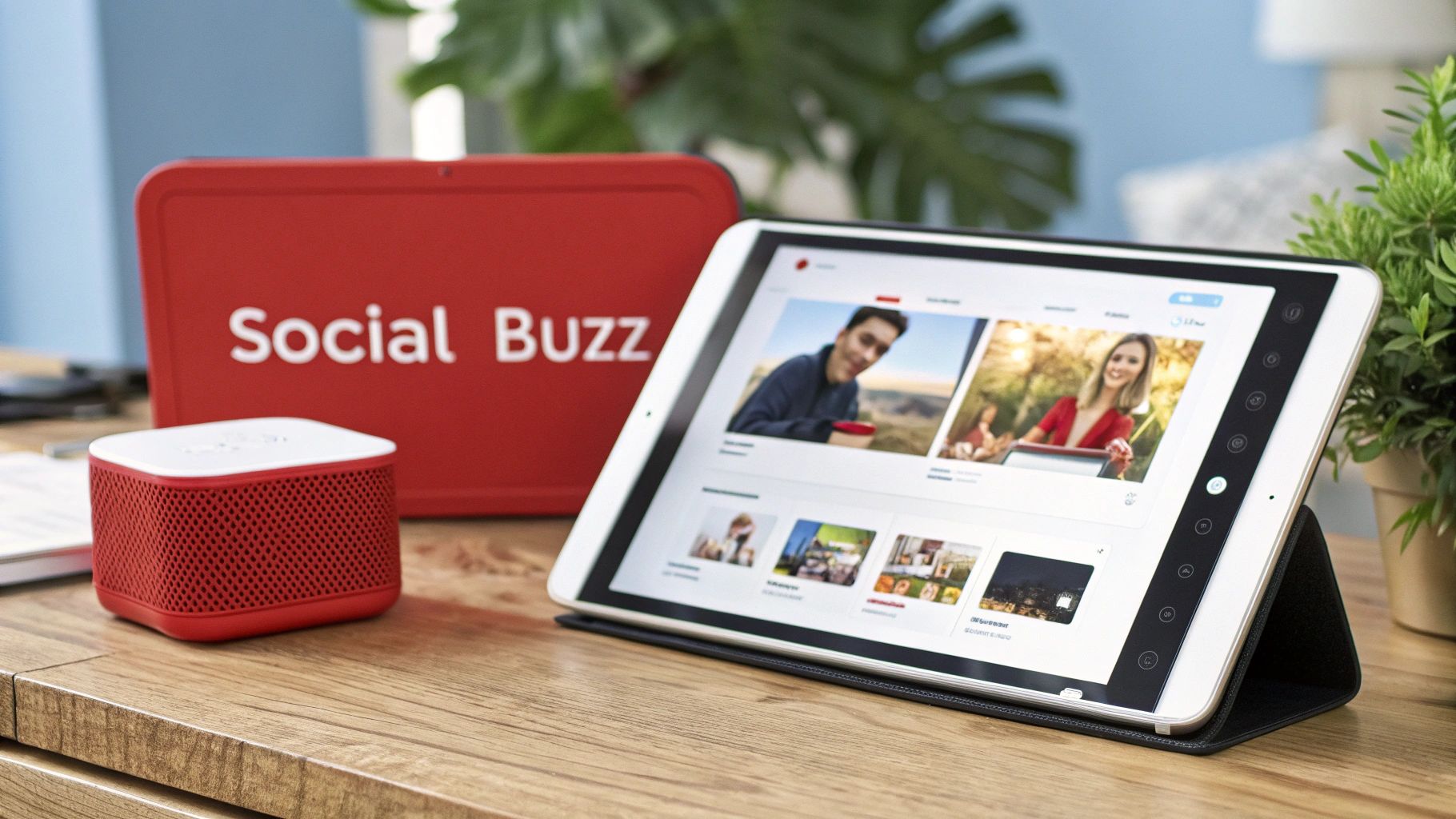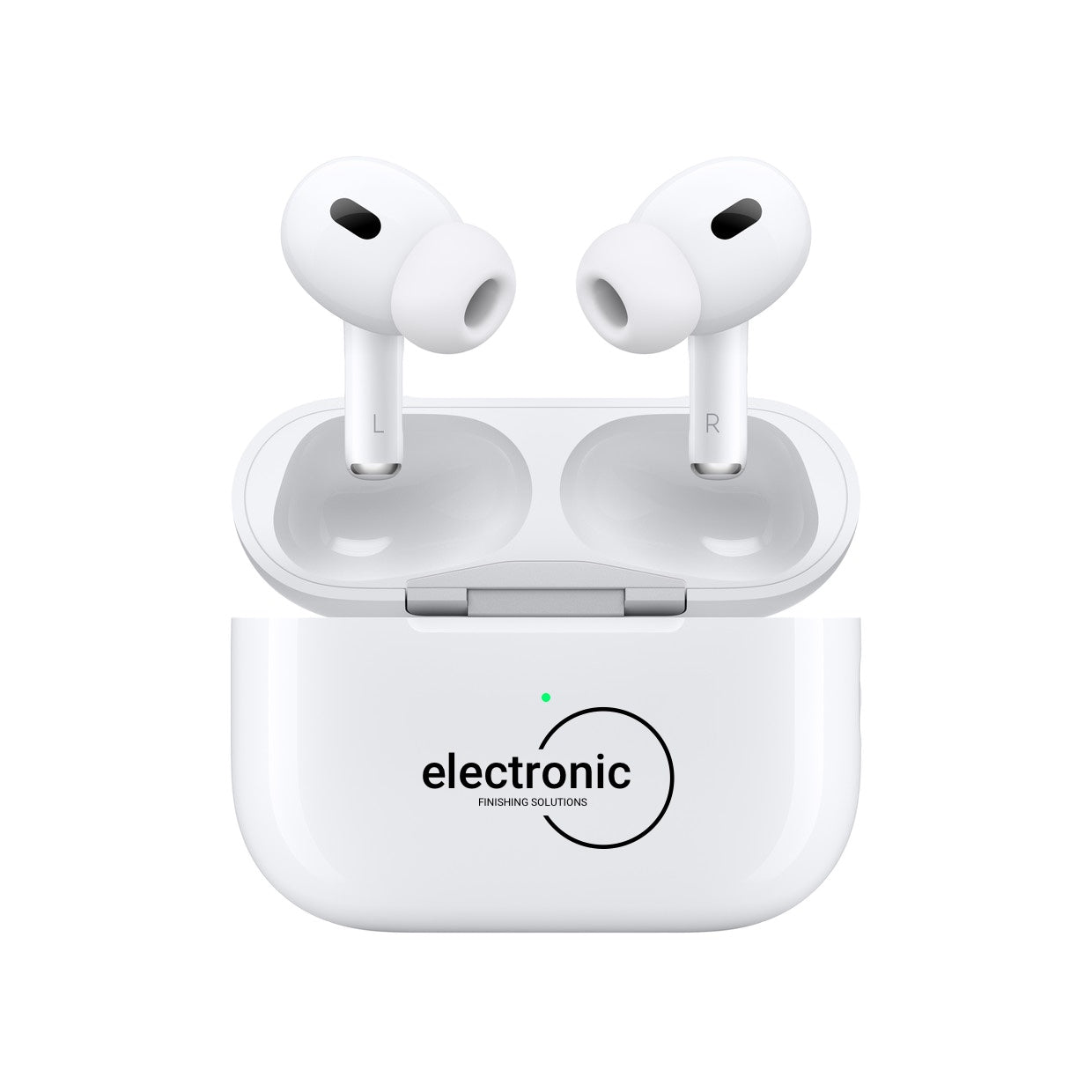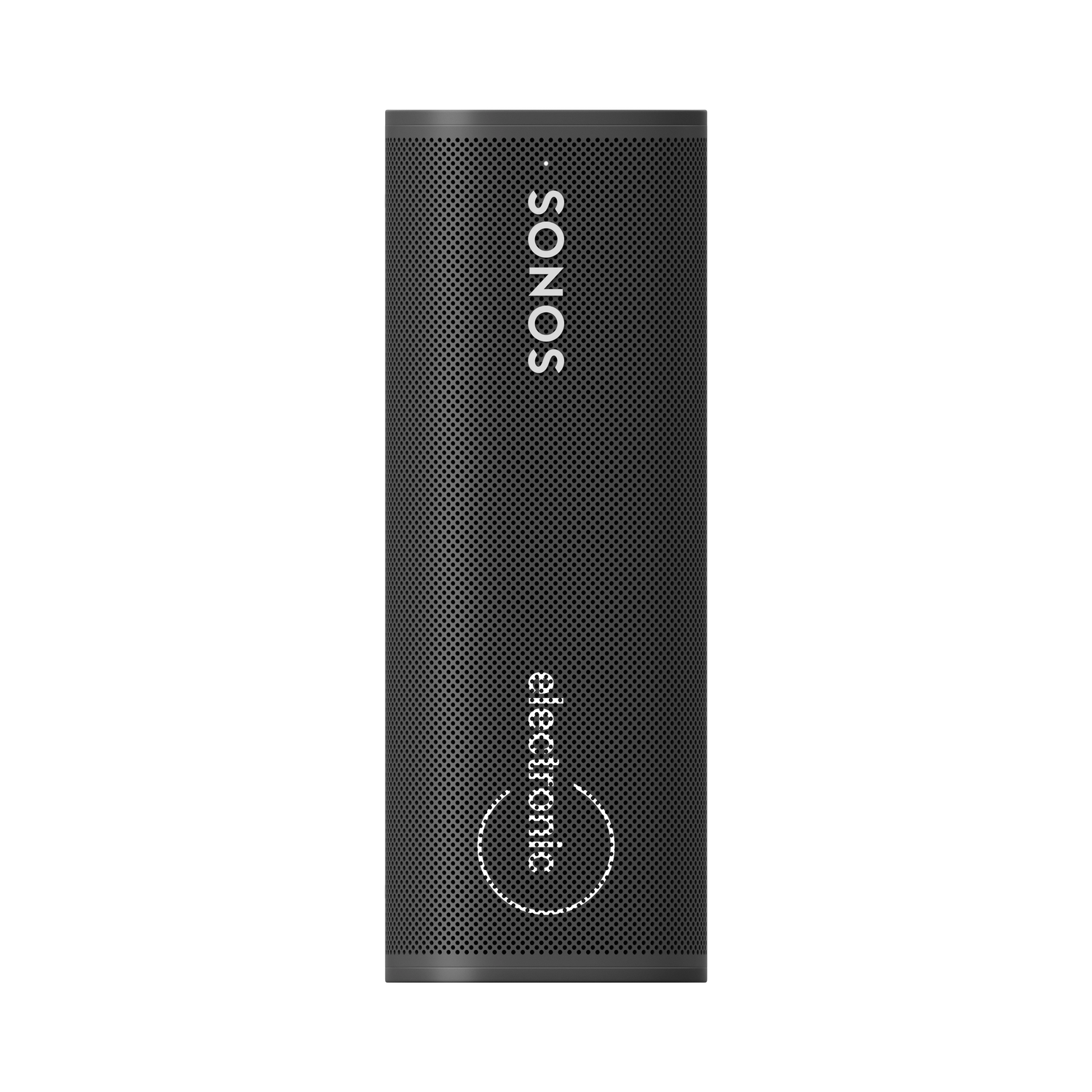Why Brand Visibility Matters More Than Ever

In today’s competitive market, simply offering a great product or service isn't enough. If your target audience can't find you, they won't become customers. This is where brand visibility becomes essential. It's the cornerstone of any successful marketing strategy. Without it, your brand remains hidden, lost in the digital clutter.
The Impact of Visibility on Your Bottom Line
Increased visibility has a direct impact on your profits. When consumers are familiar with your brand, they're more likely to choose you over a less familiar competitor. This even holds true if the competitor offers a similar product. This boost in customer acquisition is driven by the trust built through recognition. Consider your own buying habits: you're more likely to grab coffee from a familiar chain like Starbucks than an unknown local shop, even if the independent cafe might offer a better brew.
Brand visibility also cultivates customer loyalty. Customers who regularly see and engage with your brand develop a stronger connection and trust, leading to repeat purchases and positive word-of-mouth marketing. This contributes to sustainable revenue growth.
Debunking the Budget Myth
Many businesses assume that high visibility requires huge advertising expenditures. However, that's not always the case. Savvy brands utilize strategic approaches, beyond simply spending large sums, to stand out from the competition. Consistent branding plays a vital role in boosting visibility. Studies show that consistent brand presentation leads to 3.5 times higher visibility. For example, a consistent color palette can increase brand recognition by up to 80%. This underscores the importance of maintaining a unified brand image across all platforms.
Consistency builds both brand recognition and customer trust. Achieving this consistency requires a comprehensive strategy encompassing all aspects of brand identity, from visuals like logos and packaging to messaging and tone. Find more detailed statistics here.
You might be interested in: How to master sitemaps.
The Psychology of Recognition
Certain brands achieve instant recognition through specific psychological cues. A distinctive logo, consistent color scheme, or a memorable tagline can all contribute to immediate recognition. This recognition translates into consumer preference and trust, making customers more likely to choose your products or services.
For instance, Electronic Finishing Solutions specializes in customizing high-end electronics from leading tech brands like Apple and Bose, enhancing brand exposure through premium, personalized electronic products. This approach combines the familiarity of established brands with unique, targeted messaging. It leverages the existing consumer trust in these prominent brands to build brand awareness and drive business growth.
Creating a Brand Identity That Demands Attention

Consistency is vital for brand visibility. But true memorability comes from a distinct identity. Think about instantly recognizable brands like Nike or Apple. This instant recognition is the result of carefully constructed brand identities. This section explores how to develop a brand identity that captures attention and builds lasting recognition.
Visual Elements: Crafting Instant Recognition
Visual elements form the core of your brand identity. They are what customers see first and what they often remember most. Color psychology plays a crucial role. The vibrant red of Coca-Cola evokes energy, while Samsung's blue projects trust. Typography also matters. A playful font might suit a children's brand, while a sleek font works better for a tech company.
Beyond logos and color palettes, consider every visual touchpoint, from website design to packaging. These elements must work together to create a cohesive brand experience. For Electronic Finishing Solutions (EFS), this means showcasing sleek aesthetics reminiscent of premium brands like Apple and Bose while emphasizing their unique customization options. This connects high-quality, established brands with the personalized experience EFS offers.
Balancing Consistency and Evolution
Maintaining a consistent brand identity is critical, but brands must also adapt. This doesn't require a complete overhaul; it's about balancing consistency with evolution. Consider how Google subtly updates its logo, reflecting current trends while retaining core elements. This modernizes the brand without sacrificing recognition.
Auditing Your Brand for Maximum Impact
Regularly auditing your brand elements is crucial for improving visibility. This involves evaluating the effectiveness of your logo, color palette, messaging, and overall brand experience. Ask yourself: Are these elements still connecting with your target audience? Are they communicating your brand values? EFS, for instance, could analyze customer feedback on product customizations and website design to identify areas for improvement and ensure alignment with their target audience.
Maintaining Consistency Across Touchpoints
Maintaining consistency becomes more challenging as your brand grows, especially in the digital world. A clear brand style guide ensures everyone, from marketing to customer service, adheres to brand guidelines. It's a blueprint for your brand, guaranteeing a consistent experience across all touchpoints. This is crucial for EFS, allowing them to maintain a unified presence across various platforms, from their website to client presentations. Their commitment to free setups and proofs reinforces this consistency, providing clients with a predictable, high-quality experience.
To help illustrate the importance of consistency, let's look at a practical checklist.
The following table provides a comprehensive overview of elements to consider when striving for brand consistency:
Brand Identity Consistency Checklist A comprehensive checklist to ensure brand consistency across all platforms and touchpoints
| Element | Description | Implementation Tips | Consistency Check |
|---|---|---|---|
| Logo | The visual representation of your brand | Use the same logo variation across all platforms | Is the logo used consistently in size, color, and placement? |
| Color Palette | The set of colors associated with your brand | Define primary and secondary colors and their usage guidelines | Are the brand colors consistently applied across all materials? |
| Typography | The fonts used in your brand communications | Specify font families, sizes, and weights for different applications | Are the chosen fonts used consistently in all communications? |
| Messaging | The language and tone used to communicate your brand values | Develop key messages and a brand voice guide | Is the brand messaging consistent in tone and style across all channels? |
| Imagery | The visuals used to represent your brand | Curate a library of approved images and graphics | Does the imagery used align with the brand's overall aesthetic and values? |
By using this checklist, businesses can ensure a cohesive and recognizable brand identity across all touchpoints. Regular review and updates to this checklist will further enhance brand consistency as your business evolves.
Mastering Social Media for Maximum Visibility

Social media has become incredibly influential in shaping how consumers perceive brands. Posting sporadically just won't cut it anymore. A well-defined strategy is essential for truly boosting your brand's visibility.
This involves understanding the nuances of each platform and tailoring your content accordingly. For instance, short, captivating videos are TikTok's bread and butter, while LinkedIn thrives on professional networking and thought leadership.
Platform-Specific Strategies for Success
Each social media platform presents unique opportunities to amplify your brand's visibility. Instagram prioritizes high-quality visuals and engaging Stories. Facebook excels at community building through groups and targeted advertising. Twitter is the perfect avenue for real-time updates and engaging in direct conversations. You might be interested in: How to master sitemaps and other aspects. Knowing the strengths of each platform helps you maximize your impact.
- TikTok: Use trending audio and participate in challenges to expand your reach.
- Instagram: Create visually compelling content and offer behind-the-scenes glimpses through Stories.
- Facebook: Interact with your audience using polls, Q&As, and live videos.
- LinkedIn: Share insightful industry perspectives, participate in relevant discussions, and connect with other professionals.
Building Genuine Community Engagement
True visibility isn't about broadcasting your message; it's about cultivating genuine engagement. This means actively listening to your audience, responding to comments and messages, and fostering a sense of community. Treat your social media presence as a two-way conversation, not a one-way announcement.
One of the biggest factors in enhancing brand visibility is the impact of social media. A significant 77% of consumers are more likely to purchase from brands they follow on these platforms, highlighting the importance of a robust online presence. Brands that engage effectively not only improve visibility but also build loyalty and advocacy. Find more detailed statistics here. This direct interaction fosters strong emotional connections with consumers.
Advanced Tactics for Organic Reach
Beyond the basics of engagement, several advanced tactics can further elevate your brand’s visibility.
- Strategic Listening: Stay attuned to social media conversations to identify emerging trends and gain a deeper understanding of customer needs.
- Influencer Relationships: Collaborate with influencers who align with your brand values to tap into a wider and more engaged audience.
- Shareable Content Formats: Focus on creating content designed to be shared, such as infographics, quizzes, and compelling videos.
Measuring Visibility Beyond Follower Counts
While your follower count is a commonly used metric, it’s not the only measure of true visibility. Pay attention to metrics that reveal actual engagement, such as likes, comments, shares, and website clicks. These provide deeper insights into how your audience is interacting with your brand. Tracking brand mentions across different platforms can also provide a more comprehensive picture of your social media strategy's effectiveness. These mentions offer valuable feedback on public perception, allowing you to continuously refine your approach.
Emerging Platforms and Authenticity
The social media landscape is constantly evolving, with new platforms continually emerging. Staying informed about these developments and experimenting with new platforms can help you connect with fresh audiences. As you expand your social media presence, maintaining authenticity is paramount. Consumers value genuine interactions, so steer clear of overly promotional or inauthentic content. EFS, for example, can leverage social media to showcase customized products and client testimonials, highlighting the personalized experience they offer. This approach reinforces their commitment to quality and builds trust with their target audience.
Crafting a Brand Story That People Actually Remember

In today's competitive market, capturing and retaining attention is a significant challenge. A compelling brand story is essential for standing out and achieving lasting brand visibility. This goes beyond simply describing products; it's about forging genuine connections with consumers.
This section explores building narratives that resonate and enhance brand visibility.
Uncovering Your Brand's Narrative
Every brand has a unique story. This narrative might stem from the company's origins, its mission, or the positive impact its products or services have on customers. For Electronic Finishing Solutions (EFS), the story revolves around their dedication to boosting brand exposure through personalized, high-quality electronics.
This narrative directly addresses the needs of their target audience: corporate marketing teams and event coordinators seeking distinctive promotional items.
-
Origin Stories: Explain the inspiration behind your brand. What sparked its creation?
-
Customer Transformations: Illustrate the real-world positive impact of your product or service.
-
Mission-Driven Narratives: Emphasize your brand's core values and how they influence your actions.
The Psychology of Memorable Stories
Why do some stories resonate while others are quickly forgotten? Effective brand narratives often incorporate elements that tap into human psychology. These narratives might focus on overcoming challenges, celebrating shared values, or presenting a vision of a brighter future.
EFS could highlight the difficulty of finding premium, personalized tech gifts and position their customization services as the solution. This frames their offerings as a means to achieve something meaningful and memorable.
-
Emotional Connection: Stories that evoke emotion tend to be more memorable.
-
Authenticity: Consumers value genuine brands. Ensure your story is authentic and relatable.
-
Clarity and Simplicity: Keep your narrative clear and concise for easy understanding and sharing.
Aligning Storytelling With Business Objectives
Storytelling should be strategically aligned with your business goals. A successful brand story reinforces your message and supports your objectives. EFS's story, for instance, directly supports their goal of enhancing brand exposure for their clients.
By showcasing the impact of their customized products, they demonstrate value while simultaneously improving their own brand visibility. This is a mutually beneficial approach, especially relevant for EFS, whose clientele includes Fortune 100 companies and tech startups seeking high-quality promotional solutions.
Authenticity is crucial for today's savvy consumers. 86% of shoppers favor authentic and honest brands. This underscores the importance of transparency and sincerity. Effective storytelling can significantly enhance brand value, often by up to 20%. Learn more about the power of branding with these branding statistics.
Telling Your Story Across Channels
Your brand story should be integrated across all communication channels. However, tailor your approach to suit each platform. A concise, impactful video may be ideal for social media, while a longer blog post allows for a more in-depth exploration on your website.
EFS can connect with diverse audiences by adapting their storytelling. Their story is equally compelling whether shared through client testimonials on LinkedIn, product demos on YouTube, or Instagram posts showcasing their latest custom creations. This multi-channel strategy expands their reach and strengthens brand visibility.
Dominating Search Results With Strategic Content
Search engine optimization (SEO) is vital for boosting brand visibility. Think of top search results as highly coveted digital real estate. Leading brands understand this and develop content strategies designed to attract both search algorithms and human readers. This balanced approach is the secret to dominating search results and significantly enhancing brand visibility.
Keyword Research for Brand Building
Effective keyword research forms the bedrock of any successful SEO strategy. It's not simply about finding popular search terms; it's about pinpointing keywords that resonate with your brand and target audience. For a business like Electronic Finishing Solutions (EFS), this might mean focusing on keywords like "custom branded electronics," "corporate gifts," and "premium promotional products." These terms not only reflect EFS’s offerings but also connect with their target audience of corporate marketing teams and event coordinators.
Content Frameworks That Tell a Story
SEO-friendly content shouldn't be dull and robotic. Instead, it should weave a compelling narrative that resonates with readers while also satisfying search engine requirements. Think of it as crafting a beautiful tapestry: the keywords are the threads providing structure, while the brand story is the intricate design that captures attention. EFS can leverage its brand story by developing content that showcases the impact of personalized tech gifts, highlights client success stories, and emphasizes the artistry of their customizations. This approach aligns perfectly with SEO best practices while reinforcing their unique brand narrative.
Quick Wins and Long-Term Strategies
Improving search visibility requires both short-term tactics and long-term strategies. Quick wins could include optimizing existing website content for relevant keywords and building high-quality backlinks. Long-term success, however, hinges on a sustainable content strategy focused on creating valuable, engaging content that consistently attracts and retains an audience. For EFS, this could involve creating blog posts discussing the latest trends in corporate gifting, developing downloadable guides on maximizing brand exposure through personalized electronics, or publishing case studies demonstrating the ROI of their services. For information about product sitemaps, see How to master product sitemaps.
Measuring Content Performance and Adapting to Change
Measuring content success goes beyond simply tracking keyword rankings. Focus on key metrics that reflect genuine user engagement, such as time spent on page, bounce rate, and conversion rates. These metrics provide valuable insights into whether your content truly resonates with your target audience and drives desired actions. Moreover, search engine algorithms are constantly changing, so adaptability is paramount. Staying informed about the latest algorithm updates and adjusting your content strategy accordingly is essential for maintaining and enhancing brand visibility over time. Think of it like navigating a ship – you need to adjust your course based on shifting winds and currents to reach your destination.
Local Visibility and Competitive Displacement
For businesses like EFS, local search visibility is especially crucial. Optimizing their online presence for local searches ensures they appear prominently in search results when potential clients search for "custom electronics" or "corporate gifts" in their geographic area. Furthermore, strategically outranking competitors in search results is a key element of capturing market share. This involves identifying the keywords your competitors are targeting and developing even more compelling and comprehensive content around those same terms. Think of it as a strategic game of chess, carefully positioning your content to occupy the most valuable search territory.
To further illustrate content strategies, let's examine a comparison of different content types and their impact on brand visibility.
The following table provides a comparison of various content types and their effectiveness for improving brand visibility.
Brand Visibility Content Types Comparison: Analysis of different content formats and their effectiveness for improving brand visibility.
| Content Type | Visibility Impact | Resource Requirements | Best Platforms | Measurement Metrics |
|---|---|---|---|---|
| Blog Posts | High, drives organic traffic | Moderate writing and SEO skills | Company website, Medium, social media | Website traffic, social shares, lead generation |
| Case Studies | Medium, builds credibility | High research and writing effort | Company website, industry publications | Lead generation, sales conversions |
| Infographics | Medium, visually appealing | High design skills, data analysis | Social media, company website | Social shares, website traffic |
| Videos | High, engaging format | High video production skills | YouTube, Vimeo, social media | Views, engagement, website traffic |
| Ebooks & White Papers | Medium, lead magnet potential | High research and writing effort | Company website, lead capture forms | Downloads, lead generation |
This table highlights the various content formats available and their potential for enhancing brand visibility. While blog posts and videos offer high impact due to their engaging nature, they may require more resources. Conversely, while case studies and white papers require substantial research and writing effort, they build credibility and effectively generate leads. Choosing the right mix of content depends on your specific goals and available resources.
By understanding the strengths and weaknesses of each content type, businesses can create a comprehensive content strategy that drives visibility and achieves desired results.
Strategic Partnerships That Amplify Your Reach
Strategic partnerships offer a powerful way to boost brand visibility and connect with new customers. These collaborations can significantly expand your brand's influence and introduce your company to potential clients you might not otherwise reach. This section explores how smart brands identify and secure these valuable partnerships.
Identifying the Right Partners
The first step in building a successful partnership is identifying brands whose audiences complement your own. Think of it like assembling a puzzle: you're looking for pieces that fit seamlessly together. Avoid direct competitors. Instead, look for brands in related industries that share similar values and target a similar demographic, without overlapping your products or services. For example, a fitness apparel company might partner with a health food business, expanding both brands' reach within the health-conscious consumer market.
Crafting a Winning Partnership Proposal
Once you've identified potential partners, crafting a compelling proposal is key. Clearly outline the mutual benefits of the partnership. What unique value does each brand bring? How will the collaboration boost brand visibility for both parties? Present a detailed plan outlining the scope of the partnership, including specific initiatives and projected outcomes. This shows preparedness and commitment to a successful collaboration. Check out our guide on How to master sitemaps.
Structuring Agreements and Measuring ROI
A well-structured partnership agreement is essential for ensuring a mutually beneficial outcome. Clearly define roles, responsibilities, and expectations. Establish key performance indicators (KPIs) to track the partnership's success and measure the return on investment (ROI). This ensures transparency and accountability, creating a foundation for a smooth and productive working relationship.
High-Investment vs. Resource-Light Opportunities
Partnership opportunities exist for brands of all sizes, from high-investment collaborations to resource-light initiatives. High-investment partnerships might involve co-branded product development or large-scale marketing campaigns. Resource-light options, like cross-promotions on social media or joint webinars, offer a cost-effective way to expand your reach. Choosing the right approach depends on your specific goals and available resources.
The Power of Unexpected Cross-Industry Partnerships
Some of the most successful partnerships are those that break traditional industry barriers. These unexpected collaborations can generate substantial visibility gains by accessing entirely new audiences. For example, a luxury car brand partnering with a high-end coffee company might seem unusual at first. However, this type of partnership connects both brands with a shared audience that values quality and exclusivity.
Learning from Success: Applying Key Principles
Analyzing successful partnerships provides valuable insights. What made these collaborations thrive? What were the key drivers of their success? By understanding the elements of effective partnerships, you can apply those principles to your own brand and create collaborations that deliver measurable results. For Electronic Finishing Solutions, this might involve exploring partnerships with corporate event planners or marketing agencies, connecting them with clients looking for unique, high-quality promotional items. This leverages existing networks and expands EFS's reach within their target market.
By strategically forming partnerships, brands can significantly improve their visibility, connect with new audiences, and achieve sustainable growth. This approach, executed effectively, strengthens brand recognition and market presence.
Measuring What Matters: Visibility Metrics That Drive Growth
Improving brand visibility is an ongoing process. How do you know if your efforts are producing results? You can't improve what you don't measure. Focusing on the wrong metrics can be just as damaging as not measuring at all. This section explores building a robust measurement system to track progress and demonstrate the return on investment (ROI) of your brand visibility initiatives.
Key Visibility Indicators That Predict Growth
Choosing the right metrics is the first step. Different channels require different indicators. On social media, follower count isn't enough. True engagement metrics, such as likes, comments, shares, and click-through rates, offer a deeper understanding of audience interaction. Learn more about social media metrics with Sprout Social. In search, focus on keyword rankings, organic traffic, and time spent on page. These metrics reveal how well your content attracts and retains visitors. For Electronic Finishing Solutions (EFS), tracking conversions, such as quote requests or product inquiries, demonstrates the direct impact of visibility on lead generation.
Setting Up Measurement Systems (Without a Data Science Degree)
You don't need to be a data scientist to set up a practical system. Many user-friendly tools simplify the process. Google Analytics provides invaluable data on website traffic, user behavior, and conversion tracking. Social media platforms offer built-in analytics dashboards to monitor engagement. For a business like EFS, integrating CRM data with website and social media analytics can create a complete view of the customer journey, from initial brand exposure to conversion.
Establishing Meaningful Benchmarks and Executive Dashboards
Benchmarks provide context for your metrics. Comparing your performance against industry averages or your past results helps gauge progress and identify areas for improvement. Executive dashboards consolidate key metrics into an easy-to-understand format for stakeholders. Visualizing data through charts and graphs simplifies communicating the impact of brand visibility on business objectives. For EFS, an executive dashboard could showcase the relationship between increased website traffic from targeted keywords and the number of high-value leads generated.
Addressing Attribution Challenges and Demonstrating Value
Attributing specific business outcomes solely to brand visibility efforts can be complex. However, you can link visibility to tangible results. Track the customer journey from the initial brand interaction to conversion, noting touchpoints where visibility played a role. For EFS, this might involve analyzing how brand mentions on social media or high rankings for relevant search terms correlate with increased website traffic and subsequent product inquiries. This data reinforces the effectiveness of brand visibility initiatives.
Continuous Optimization: Adapting to Evolving Markets
Maintaining and enhancing brand visibility requires continuous monitoring and adaptation. Consumer behavior, market trends, and even search algorithms constantly change. Regularly review your metrics, analyze trends, and adjust your strategies based on the data. For example, if EFS notices declining engagement on a specific social media platform, they might shift resources to other, higher-performing channels or test new content formats. This proactive approach ensures your brand remains visible and competitive.
Ready to elevate your brand's visibility and achieve lasting growth? Discover how Electronic Finishing Solutions can help you customize premium electronic products to make your brand stand out.



